A low-cost laser that could save the lives of British soldiers serving in Afghanistan has been developed by a team of physicists at St Andrews University.
The researchers have made a device that can trace tell-tale vapours emitted by explosives such as TNT.
The scientists say it will work like “an artificial nose for a robot dog,” sniffing out vapours at very low concentrations.
As well as helping detect landmines and roadside bombs, the technology could improve airport security.
Using a thin film of polyfluorene a light-emitting plastic researchers have created a laser that dims within seconds when the plastic comes into contact with even the tiniest emission.
Dr Graham Turnbull of the university said, “Floating above a landmine in Iraq or Afghanistan there’s a very weak, dilute cloud of vapours of explosive molecules that the bomb is made from.
“We have shown our lasers can rapidly sense these TNT-like molecules, frequently used in explosives, at extremely low concentrations.”
The team says the laser could be built into a remotely-controlled robotic device that could be sent into a mine field looking for vapour clouds.
Dr Turnbull said, “On a dusty road in Afghanistan there are relatively few things that might affect the laser output, and it certainly could have potential in that area.”
One advantage over existing methods is that the new technology is relatively low-cost, since polyfluorene is widely used in plastic electronics.
The research, published this week in the journal Advanced Functional Materials, was carried out by Dr Turnbull, Ying Yang and Ifor Samuel.
Photo used under Creative Commons licence courtesy of Flickr user United Nations Photo.
